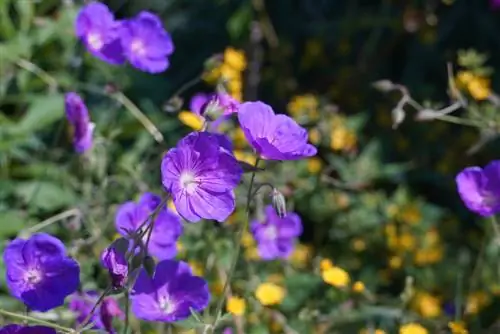- Author admin [email protected].
- Public 2023-12-16 16:46.
- Last modified 2025-01-23 11:22.
Storksbills have been found in our gardens, on terraces and balconies for decades. Due to the high species diversity, the plants are particularly versatile in the garden. In order for the plants to thrive, knowledge of the respective species and its requirements is necessary.

How can you identify different cranesbill species?
To identify cranesbill species, pay attention to height, leaf shape, flower size and flower color. An overview of different types will help you narrow down your selection. Then compare the criteria with a cranesbill profile for an exact identification.
How can I identify the different cranesbills?
Based onthe different growthyou can determine the species of cranesbill. To identify them, choose an overview of the many species. First of all, you canthe height of growth and narrow down the selection significantly. During the flowering period, you then limit the number of flowers based on the size and color of the flowers. The cranesbill leaves serve as a further criterion. Depending on the species, these are lobed or rounded very differently.
- Bloody Cranesbill
- Forest Cranesbill
- Meadow Cranesbill
- Soft cranesbill
Once you have made a determination based on these criteria, check your selection based on the specific cranesbill profile.
Why does it make sense to identify cranesbills?
If you identify cranesbill correctly, you can meet theindividual needs of your plant. Cranesbills differ in their location requirements. In addition to sunny to partially shaded places, there are also species for shade. While some species such as the meadow cranesbill prefer humus-rich soils, the rock cranesbill is very undemanding. By choosing the right location, you will avoid stunted growth and will be rewarded with an abundant and long flowering period.
What types of cranesbills are there?
The cranesbill family (geranium in Latin) includesapproximately 400 species worldwide. Native cranesbill species in Germany are:
- Blood-red cranesbill,
- Forest Cranesbill
- Meadow Cranesbill
- Soft cranesbill
- Little Cranesbill.
- stinking cranesbill
Many popular species come from southern and eastern Europe:
- Armenian cranesbill,
- Brown Cranesbill
- Balkan cranesbill (also rock cranesbill)
Imported from other areas:
- Basque cranesbill
- Caucasian cranesbill.
In addition, alarge number of new varieties have been bred in recent years. The species listed with their persistent flowers are particularly popular as ornamental plants. Only the little cranesbill grows as a weed along the side of the road.
How do the different cranesbills differ?
The cranesbill species differ significantlyin height and leaf shapeFirst, you can determine whether it is a perennial or a ground cover by the height of the plant. The height varies between 15 and 100 cm. Theflower colors are also different and vary between white, pink, crimson and purple. While the stinking cranesbill only has pink flowers about two centimeters in size, the meadow cranesbill impresses with large, mostly delicate blue tones, according to its profile.
Tip
Can I identify cranesbills with an app?
Some cranesbill species can actually be identified using a plant identification app. However, there are usually only a few species present there. Online plant portals and books offer a larger selection and usually contain species and varieties.






